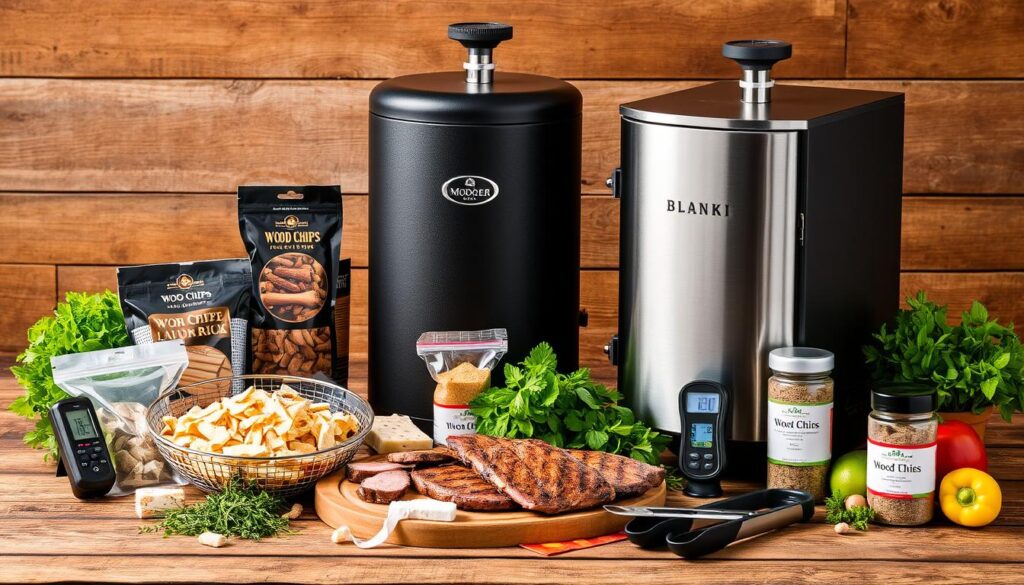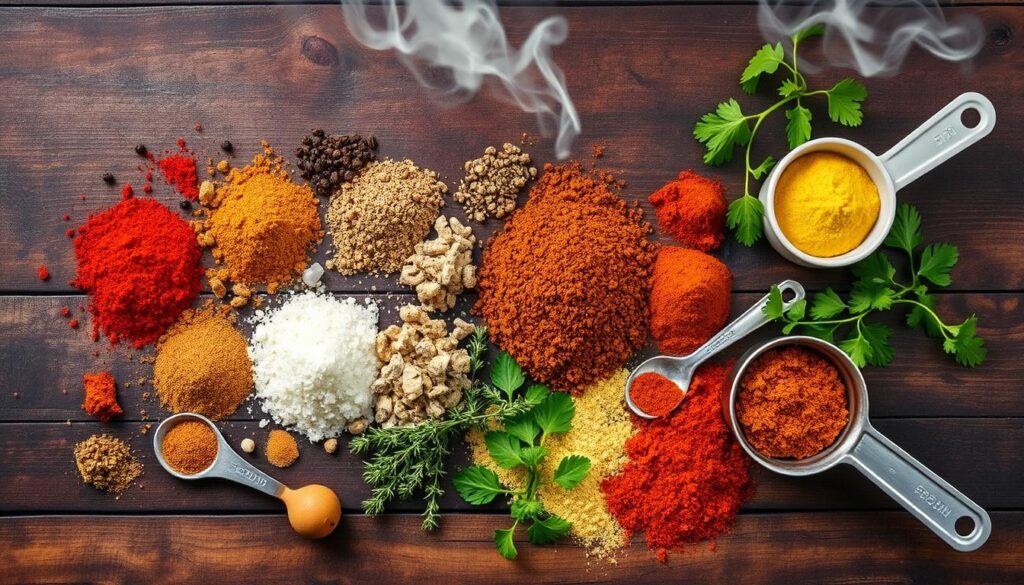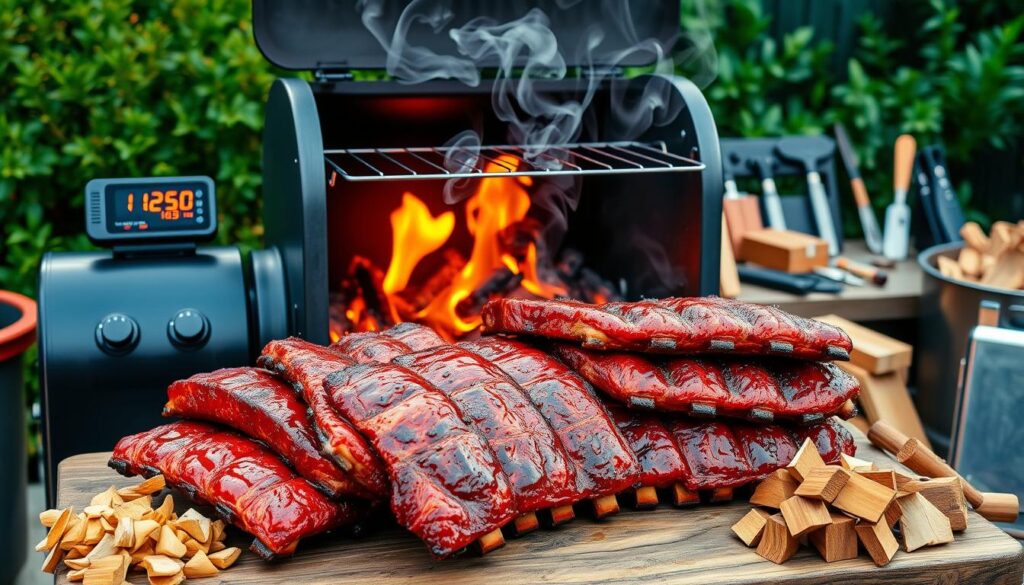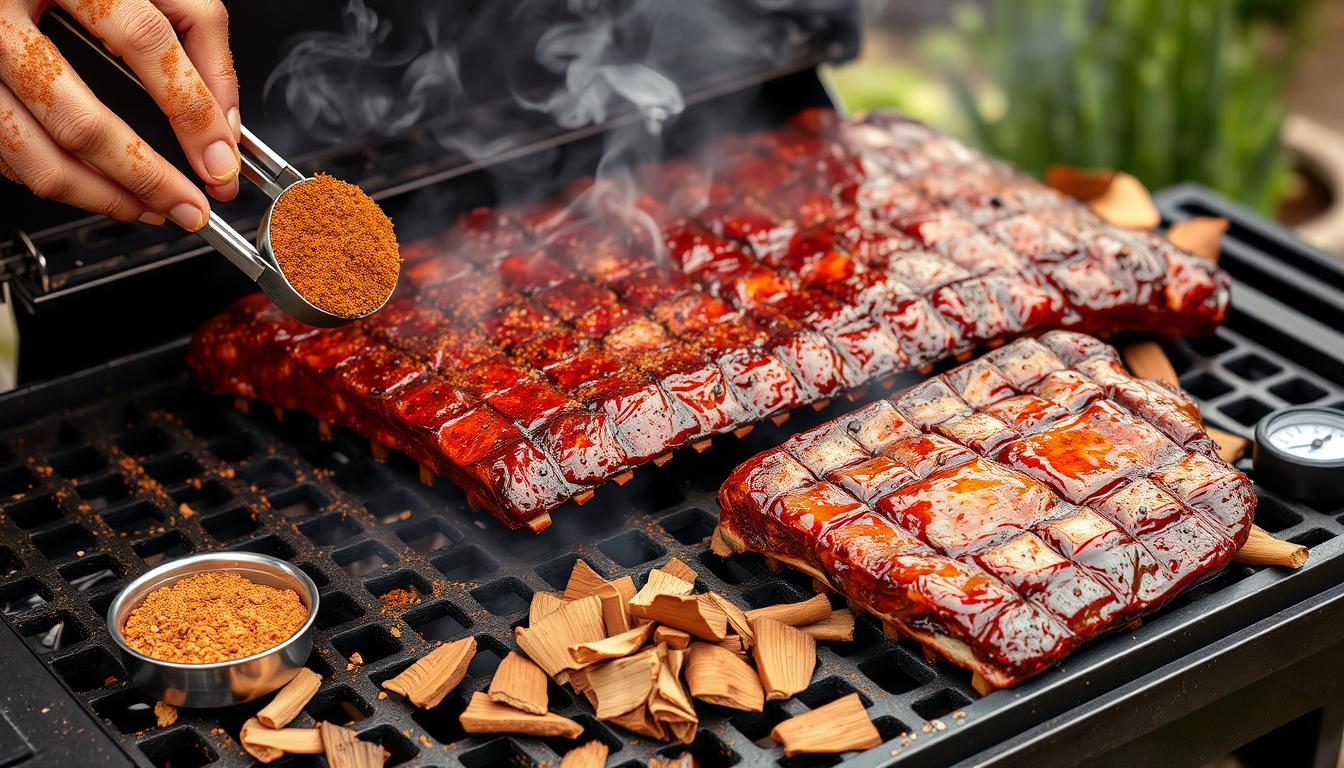The first time I fired up my smoker, the smell of barbecue ribs filled the backyard. It turned a simple weekend gathering into a memorable meal. Smoking ribs is more than cooking – it connects us to outdoor cooking traditions.
Whether you’re a backyard cook or a pitmaster in training, mastering smoked meat takes passion and skill. In this guide, I’ll share secrets that make your ribs stand out. These tips will help you go from average to amazing.
Key Takeaways
- Learn professional techniques for smoking ribs
- Understand meat selection and preparation
- Master temperature control and wood selection
- Develop perfect dry rub and sauce techniques
- Avoid common smoking mistakes
Understanding Different Types of Ribs for Smoking
Choosing the right pork ribs is key to making delicious rib recipes. Not all ribs are the same. Knowing the differences can make your smoking skills top-notch.
Baby Back vs. Spare Ribs
There are two main types of pork ribs: baby back and spare ribs. Baby back ribs are shorter, with 3 to 6 inches in length. They have 10 to 13 ribs per rack. They are tender and cook faster, needing about 3-4 hours to smoke.
- Baby Back Ribs:
- Smaller and more tender
- Shorter cooking time (3-4 hours)
- Less meaty compared to spare ribs
- Spare Ribs:
- Larger and meatier
- Longer cooking time (5-6 hours)
- Come from the belly of the pig
Selecting Quality Meat
The quality of your ribs is what makes your recipes shine. Choose ribs with good marbling and a fresh, pinkish-red color. Steer clear of ribs with too much fat or dark spots.
| Rib Type | Meat Characteristics | Cooking Time |
|---|---|---|
| Baby Back | Tender, leaner | 3-4 hours |
| Spare Ribs | More meat, rich flavor | 5-6 hours |
| St. Louis Cut | Trimmed, squared spareribs | 4-5 hours |
Membrane Removal Techniques
Removing the membrane is a pro tip for better flavor. Gently slide a knife under the membrane at one end of the rack, then pull it off using a paper towel for grip. This lets your dry rub and smoke get into the meat better.
“The secret to great pork ribs is in the preparation and selection of meat.” – BBQ Experts
Essential Equipment for Smoking Ribs
Mastering the art of smoking ribs takes more than just passion. You need the right BBQ tools and smoker types for mouth-watering results. Professional pitmasters know that quality equipment can turn an average cook into a legend.

- Temperature control capabilities
- Fuel efficiency
- Cooking space
- Durability
The Meadow Creek SQ36 offset stick burner is a top choice. It can handle up to 6 racks of baby back ribs on the main grate. Plus, it can fit an additional 6 racks on the second tier.
“The right tools make all the difference between good and great barbecue.” – BBQ Pitmaster
Here are the critical BBQ tools for successful smoking:
| Tool | Purpose |
|---|---|
| Remote Probe Thermometer | Monitor smoker and meat temperatures |
| Temperature Controller | Reduce margin of error in heat management |
| Heat-Resistant Gloves | Protect hands during high-temperature cooking |
| Basting Brush | Apply glazes and marinades |
Pro tip: Invest in quality accessories that enhance your smoking experience. They help you maintain consistent temperatures between 225-250 degrees Fahrenheit.
By understanding your equipment and practicing your grilling techniques, you’ll soon be smoking the most delicious ribs in the neighborhood.
The Perfect Dry Rub Recipe for Smoking Ribs
Making the ultimate rib rub is an art that turns simple meat into a delicious BBQ treat. The right mix of spices can take your smoking skills to the next level. It will impress even the pickiest BBQ fans.

Creating the perfect BBQ seasoning is all about precision and knowing how flavors work together. Your dry rub is the key that adds a deep, rich taste to every bite of smoked ribs.
Base Ingredients for a Classic Rub
A top-notch rib rub begins with the right ingredients. Here’s a recipe for six rib racks:
- 1/2 cup brown sugar
- 1/4 cup paprika
- 1 tablespoon black pepper
- 1 tablespoon kosher salt
- 1 tablespoon chili powder
- 1 tablespoon garlic powder
- 1 tablespoon onion powder
- 1 teaspoon cayenne pepper
Balancing Sweet and Spicy Flavors
The secret to great BBQ seasoning is finding the right balance of sweet and spicy. Different areas have their styles:
| Style | Flavor Profile | Key Characteristics |
|---|---|---|
| Kansas City | Sweet | More brown sugar, complex spices |
| Memphis | Spicy | Less sugar, more cayenne |
Application Techniques
Getting good at rib rubs means knowing how to apply them right. Here are some pro tips:
- Pat ribs dry with paper towels
- Apply rub 10-30 minutes before cooking
- Massage spices well into the meat
- Let rub sit to deepen flavors
“A perfectly balanced dry rub transforms good ribs into an unforgettable culinary experience.” – BBQ Pitmaster
Keep your custom spice blend in a cool, dark spot for up to six months. This keeps the flavors strong for your next BBQ.
Temperature Control and Wood Selection

Mastering the art of temperature control is key to making delicious ribs. The ideal temperature for smoking pork ribs is between 225 to 250°F. This range ensures slow cooking that tenderizes the meat.
Choosing the right wood chips can greatly improve your ribs’ flavor. Various woods offer different tastes:
- Hickory: Strong, bacon-like flavor
- Mesquite: Intense, bold taste
- Apple: Sweet, mild smokiness
- Cherry: Mild, fruity undertones
Keeping the heat steady is essential. Fluctuations can make the meat tough. Use a digital thermometer like Thermapen ONE to monitor temperatures accurately.
| Rib Type | Ideal Smoking Temp | Recommended Cooking Time |
|---|---|---|
| Baby Back Ribs | 250°F | 4-5 hours |
| Spare Ribs | 225-250°F | 5-6 hours |
“Patience and precise temperature control are the keys to achieving perfect smoked ribs.” – BBQ Pitmaster
To get the perfect smoke ring and tender meat, you need to know your smoker well. Practice keeping the heat consistent.
Mastering the Art of Smoking Ribs
Smoking ribs is a delicate craft requiring patience, skill, and precise techniques. Professional BBQ masters have found ways to turn ordinary meat into mouthwatering delicacies. These dishes will impress any crowd.
The 3-2-1 Method Explained
The 3-2-1 method is a well-known rib cooking approach. It breaks down the smoking process into three stages:
- 3 hours: Smoke the ribs directly on the rack
- 2 hours: Wrap ribs in foil with liquid (apple juice or BBQ sauce)
- 1 hour: Unwrap and finish with direct heat
“Patience is the secret ingredient in perfect BBQ methods” – Pitmaster wisdom
Smoke Ring Formation
The smoke ring is a pink layer found just below the surface of the meat. It’s a sign of great smoking techniques. It forms when nitrogen dioxide from wood smoke meets the meat’s myoglobin.
Maintaining Consistent Temperature
Temperature control is key in rib cooking. Maintain a temperature of 225-250°F to achieve the best results. Use a reliable thermometer and adjust vents or fuel to keep it steady.
- Check temperature every 30-45 minutes
- Use wood chunks like oak and hickory for a robust flavor
- Avoid opening the smoker too frequently
By mastering these techniques, you’ll turn your backyard BBQ into a gourmet experience that rivals professional smokehouses.
Saucing Techniques and Timing
Learning how to apply BBQ sauce is key to making your smoked ribs stand out. The right way to glaze can change the flavor and add that perfect shine. It’s what every pitmaster aims for.
Timing is key for flavor. Experts say to put BBQ sauce on during the last 30-45 minutes. This avoids burning and boosts the taste.
- Hold off until the final 30-45 minutes of cooking
- Apply sauce in thin, even layers
- Brush sauce multiple times for deeper flavor
- Allow each layer to caramelize slightly
“The secret to great BBQ sauce is balance between sweet, tangy, and spicy elements.”
There are different ways to sauce your ribs, each changing the taste:
| Technique | Flavor Impact | Recommended Use |
|---|---|---|
| Brushing | Controlled, even coating | Most traditional method |
| Mopping | Moisture retention | Large cuts, longer cooks |
| Glazing | Intense flavor concentration | Final 15-20 minutes |
The aim is to enhance your smoke flavor, not cover it up. A gentle touch with BBQ sauce can elevate your smoked ribs from good to amazing.
How to Test for Doneness
Finding the right rib doneness is an art. It mixes different methods. Smoking ribs needs careful attention and precise measurements. This guarantees your meat remains tender and juicy.
The Bend Test Method
The bend test is a classic way to check rib doneness. Hold the rack with tongs and gently bounce it. If the ribs crack slightly and bend easily, they’re tender.
Temperature Guidelines
Meat thermometers are key for accurate cooking. The USDA says pork should be at 145°F. But, smoked ribs need a higher temperature, between 201°F and 210°F, for the best tenderness.
| Rib Doneness Level | Temperature Range | Texture |
|---|---|---|
| Rare | 145°F | Firm |
| Medium | 195°F | Slight Tug |
| Well-Done | 203°F-210°F | Fall-Off-the-Bone |
Visual Indicators
Look for these signs when checking rib doneness:
- Meat pulling back from the bone
- Slight surface cracking
- Rich, deep mahogany color
“The key to perfect ribs is patience and precision in measuring doneness.”
Remember, overcooking makes the meat dry and stringy. It’s better to be a bit underdone. This way, ribs get even tenderer while resting. Aim for a mix of moisture and smoky texture.
Common Smoking Mistakes to Avoid
Smoking ribs is more than just grilling meat. It’s about mastering BBQ techniques to avoid common mistakes. These errors can ruin your meal.
Here are key tips to avoid disasters when cooking ribs:
- Avoid starting fires with lighter fluid, which can destroy delicate meat flavors
- Manage temperature carefully to prevent burnt or tough ribs
- Use thin, blue smoke instead of thick white, or gray smoke
- Control wood chip selection for optimal flavor profiles
Temperature control is key when smoking ribs. Small, clean-burning fires produce the best results. Most mistakes happen when heat isn’t kept between 225-250°F.
“Patience separates good BBQ from great BBQ” – Professional Pitmaster
Choosing the right wood is important. Different woods give unique flavors:
| Wood Type | Flavor Profile | Best Used With |
|---|---|---|
| Hickory | Strong, bacon-like | Pork Ribs |
| Apple | Sweet, mild | Chicken, Pork |
| Mesquite | Intense, earthy | Beef Ribs |
Smoking is an art that takes practice. Every mistake teaches you about temperature, smoke, and meat.
Conclusion
Mastering smoked ribs is an art that combines science, technique, and creativity. Your outdoor cooking skills will grow as you try different smoking methods. This includes the classic 3-2-1 technique and more complex methods for baby back and spare ribs. Each rack you smoke helps you develop your BBQ style.
The secret to amazing ribs is knowing three key things: environment, ingredients, and timing. Whether you use a charcoal grill or a smoker, keeping temperatures between 225-250 degrees F is key. Your patience and willingness to try new things will help you become a BBQ master.
Great smoking techniques take practice. Begin with basics like removing the membrane and applying a dry rub. Also, learn about managing moisture. Don’t hesitate to adjust cooking times based on your ribs’ unique qualities. Your outdoor cooking journey is about learning and enjoying the process.
Smoking ribs is more than just cooking—it’s a culinary adventure. It connects you to American barbecue traditions. Keep exploring, stay curious, and enjoy every smoky, tender bite you make.
FAQ
What’s the difference between a baby’s back and spare ribs?
How do I remove the membrane from ribs?
What type of smoker is best for beginners?
How long should I smoke ribs?
What wood chips work best for smoking ribs?
How can I tell if my ribs are fully cooked?
Should I apply BBQ sauce during or after smoking?
What’s the most common mistake when smoking ribs?
How important is a dry rub for smoking ribs?
Can I smoke frozen ribs?
What did you think of our recipe?
There are no reviews yet. Be the first one to write one.

